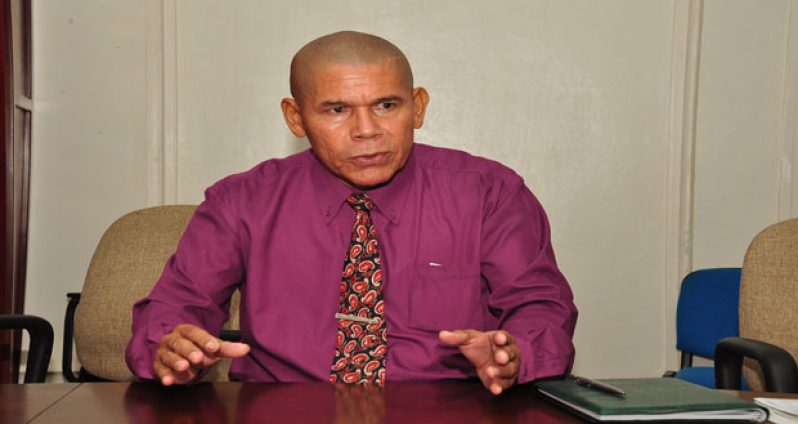GUYANA has one of the highest rates of maternal mortality and teenage pregnancies contribute to that risk factor as the country has recorded 16 maternal deaths so far this year, according to Minister of Public Health Dr George Norton.Guyana has exceeded the maximum Millennium Development Goal (MDG) limit of 11 maternal deaths this year, as it continues to struggle with the issue.
A shortage of skilled obstetricians has been listed as one of the biggest challenges Guyana has had in its efforts to reduce its maternal mortality rate.
Government has allocated in the 2015 budget over $133.1 million for the expansion of the Georgetown Public Hospital Corporation (GPHC) maternity unit, increasing its capacity by 50 beds.
Minister Norton said the maternal mortality rate is getting worse and government will be recruiting additional expertise in the field of Obstetrics and Gynaecology in an effort to reduce maternal mortality.
A report, Norton said, subtitled “Motherhood in childhood – facing the challenges of adolescent pregnancy,” stated that the Latin American and Caribbean Region has an adolescent birth rate of 73 per 1,000 girls and a maternal mortality ratio of 81 per 100,000 live births.
Teenage pregnancy crisis
He said teenage pregnancies have escalated into a global crisis with more than seven million teenaged girls in poor countries giving birth before the age of 18 years. Girls under the age of 15 have accounted for over two million of the 7.3 million girls who are impregnated each year and the current trends remain.
“It is estimated that there will be an upsurge of adolescent birth among girls under 15, swelling to 3 million a year in the year 2030. According to the world population report in 2013, Guyana has had the second highest rate of adolescent pregnancies in both the Caribbean and South America, with 97 out of every 1000 girls between the ages of 15-19 giving birth,” he said
Mentioned in the same report, he said motherhood in childhood is an oversight that is plaguing the developing world and stripping young girls of their human rights and physical and psychological health.
The vast majority of teenage pregnancies, at least 82 per cent, unintended, unplanned and unwanted pregnancies lead to several problems in society.
With this in mind, Dr Norton said the Ministry of Public Health through its Maternal, Child and Adolescent Health Promotion Unit, along with the Education Ministry has recognised the challenges faced by young people in general and as such will undertake several approaches to implement strategies which focus primarily on teenage pregnancy in Guyana.
Dr Norton said it distresses him whenever he reads the newspapers and sees there is another maternal death, as he made reference to a news article on a 17 year old who had her third pregnancy and third C-section. It meant that she would have had her first pregnancy at 13 years of age which boils down to lack of education.
Although CARICOM has committed to family life health education programmes, little progress has been made in its implementation through the school system. Minister Norton noted that progress has been slow although the policy has been accepted since 2001.
“We signed a paper to support some convention but we are not seeing the action, every little advice to our children counts, the taboo about sexual education must be done away with.”
He said girls in Guyana are experiencing puberty at the tender age of eight. Most of the females entering secondary school are all becoming young ladies.
“The Ministry of Public Health will work tirelessly with other ministries as well as other non-governmental organisations. Education with a strong prevention message seeks to identify and address factors that contribute to teenage pregnancies.”
Multi-sectoral approach
He said a multi-sectoral approach is being taken for the prevention of adolescent pregnancy in Guyana. The Public Health Ministry will implement creative and supportive policies to strengthen strategies for the reduction of adolescent pregnancy.
“We need to increase access to quality sexual and reproductive health services and commodities for adolescence to strengthen surveillance and monitor systems for adolescent pregnancies between the age group of 10-15 and 16-19; we definitely have to have this,” he declared.
“Many times doctors don’t have a choice because they reach the GPHC either underage or overage; we have to recognise its high risk and we have to take the necessary precautions as any kind of accident can happen.”
In addressing the issue, the Public Health Minister plans to disseminate knowledge via many mediums, including the media.
“Through the schools health clubs and peer educators, comprehensive sexual education, contraceptive access and youth development programmes will be taken to help young people make choices that can protect them from unintended pregnancies.”
In the period 2007-2011, Guyana had a reported maternal mortality ratio of 86 deaths per 100,000 live births (this figure was estimated at 280 deaths per 100,000 by United Nations agencies and the World Bank in 2010).
However, in 2013, the Health Ministry, based on the estimated number of births, recorded a maternal death rate of 79.7 per every 100,000 live births.
In 2014, a UN report ranked Guyana as second on the list for highest maternal deaths in the Caribbean after Haiti, which recorded 380 deaths between 1990 and 2013. Guyana had 250. The main direct causes recorded last year were haemorrhagic conditions, hypertension in pregnancy, eclampsia and adverse effects relating to bleeding.
By Rabindra Rooplall



.jpg)









